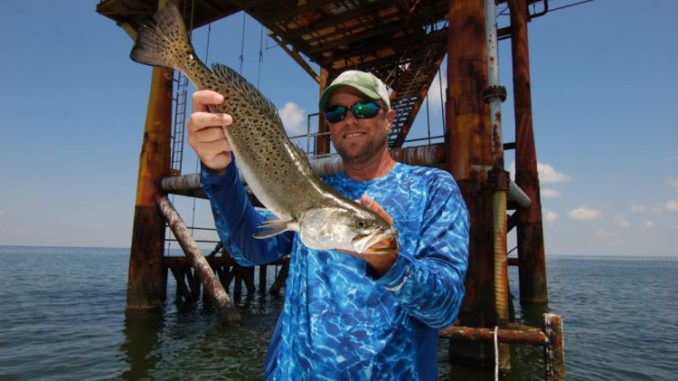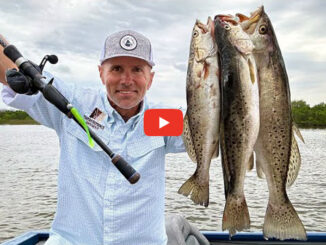
The heat is definitely on in Breton Sound right now, but you can still catch fish. Here’s how one Shell Beach guide stays on trout when the mercury soars.
Mother Nature typically cranks up the furnace on high this month, enveloping the state in a sticky, humid sauna that practically leaves anglers begging for the first cool fronts of fall.
But any chilly air is probably at least 60 days out, so the dog days of summer are definitely upon us. And while that can make fishing conditions brutal this month, the good news is you can definitely still catch fish.
Out in Breton Sound, Capt. Jakamo Laboureur targets structures this time of year to catch some nice speckled trout, which are enjoying a couple more months of spawning activity in the high-salinity water there before they begin the process of transitioning back inside to the outer bays later this fall.
You might have to do some searching, but Laboureur, who operates Jakamo South Fishing Adventures out of Shell Beach, said live shrimp and croakers — and to some extent artificial lures — all will be effective in catching trout roaming over the shell pad bottoms of the sound’s rigs and wellheads.
“In August, I’m typically taking my customers to structures in the sound, the Central Rig and that entire field, including the chair wells,” Laboureur said. “It takes some time to figure them out, but we have the ones we’ve learned with the big shell pads — that’s the key.
“With those shell pads, it’ll be 20 feet deep all around and then it comes up to 10 feet with the shell pad. So you’re not just getting the good bottom, but you’re typically getting an elevation change, and that’s huge because they can get out of the current. And with a structure like the Central Rig that’s so big, they can get behind it and seek shelter on a strong tide.”
Rigging up
Popping corks, sliding corks, Carolina rigs, artificials and free-lining live bait all can be effective methods of catching specks holding tight to rigs and structures, depending on depth, current and daily conditions.
But one thing remains constant — when Laboureur ties on a leader, it’s always 20- to 30-pound fluorocarbon.
“I know fluorocarbon is expensive, I get it,” he said. “But to me it’s about abrasion resistance more than it is being clear. It’s tougher line, so I can catch more trout without having to re-tie than if I was using a mono leader.”
With a popping cork, Laboureur’s depth limit is about 10 feet, so even at that point he’s throwing corks out with dangling 5-foot leaders. Any deeper, and he shifts over to a sliding cork, but they’re not necessarily user-friendly, either.
“The braid just doesn’t want to hold the stopper very good, so it slides down and controlling the depth can be a hassle,” he said. “They say mono works better for sliding corks because the stoppers hold.”
And when he chooses a Carolina rig, Laboureur keeps the weight as light as possible.
“Personally, I don’t like them to just sit on the bottom. I try to get away with a split shot or a ¼-ounce or maybe a ⅜ because I want to cast side-current where it will drift down, and most of your hits are on the drift,” he said. “If you don’t get a bite then, I want it to bump across the bottom just like the bait would … I don’t want it going out there like a spark plug, hitting the bottom and just sitting there.”
Interestingly enough, he’s not a big fan of the drop-shot rig.
“I don’t fool with it. I’m not a drop-shot guy,” he said with a grin. “I feel like they tangle. I think they’re effective for fishing straight underneath the boat — that’s how I used to use them out at Seabrook. But I don’t feel like they’re any more effective than a Carolina rig.”
Soft-plastics are doable if you’re a diehard artificial angler.
“If you’re there and nobody else is there, you have a real good shot of catching them on plastic,” said Laboureur, who favors a ⅜-ounce jighead in the Sound. “Quarters (of an ounce) just take too long to get down. And the bigger plastics are obviously better for the bigger trout, but as far as action goes, I don’t think it’s as much about action. I still catch fish on Sparkle Beetles. Sometimes it’s color, but at the end of the day, it’s really about finding the fish. Schooling trout don’t care, they really just don’t care.”
Live bait
Laboureur stops in at Campo’s Marina every morning to load up on shrimp and croakers before heading into the Sound.
“I typically get about 100 shrimp per person,” he said. “With croakers, I usually grab 50 to 100 if I can get them. But if they’re there, bring the croakers — they’ll definitely help you.”
If you’ve never croaker-fished for specks before, patience is key. The urge to set the hook can be strong on the first thump, but you have to really give the speck time to get the croaker in its mouth.
“What I tell my customers is don’t set the hook,” said Laboureur, who uses either a No. 1 kahle hook or a No. 6 treble hook for croakers. “I cast out and leave my bail open with my finger holding it. When you feel the thump, the line will start jumping — you’ll see it. What I’ll do is I kind of lift up on my rod a little, then click the bail so I have time to come down and come tight, and instead of like a big hook set, I just do a sweeping motion and crank as fast as I can.
“That is pretty much the best way to croaker fish. You cannot do it on the initial pop. The trout has it, but they need to get it a little deeper, and the hook also has to come through the croaker.”
Lively live bait
Laboureur feels like he has a secret weapon for keeping his shrimp and croakers more lively in the livewell this summer. It didn’t cost an arm and a leg, either, but it’s proven itself to be effective at keeping his live bait perkier.
It’s a simple saltwater aquarium filter recommended to him by his brother-in-law, who builds, maintains and installs saltwater tanks.
“Every summer, it’s a battle all day to keep your bait alive when it gets hot,” Laboureur said, noting he keeps his livewell recirculating for the most part. “The first day I put that filter in it was unreal.”
Just put the foam filter in place of one of your air stones, he said.
“It needs air to work. I had a bubble box with two pancake-style air stones, so I just pulled one of those off and installed this,” he said. “It just installs right into your vinyl tubing, so I still have one cake.”
The key to the filter’s success is that it mechanically filters the water via the foam, and also biologically treats it with bacteria living inside the filter media.
“So it cleans out the waste, and the bacteria that’s in the sponge eats up the uric acid, which is the biggest enemy of the shrimp. Not only does it clean up their waste, but also the ammonia issue,” he said.
Even better, the filter is readily available at pet stores with saltwater accessories, and it sells for about $15.
“I’ve spend hundreds of dollars trying to figure that whole thing out, and my brother-in-law was like, ‘Dude, try this thing,’” he said. “So far, I’ve been pretty impressed with it.”
Teeth
Summer predators in the sound are like death and taxes — so plan ahead and make sure you have plenty of terminal tackle onboard when they inevitably show up and try to ruin the party.
“Judging on what I’ve seen earlier this summer, I have a feeling the teeth are going to be pretty ferocious this year,” Laboureur said with a chuckle, referring to the sharks, Spanish mackerel, bluefish and even ladyfish that harassed him on a trip in early June. “To me, that’s life in the Sound.”
And Laboureur uses his catfish flipper for lots more than catfish. The only predator that doesn’t get flipped off the hook is a shark, because the guide said he wants more control over the fish if he has to deal with one up close and personal.
One way he copes with waves of predator fish, which appear to get particularly fired up after a few trout come aboard, is to play the waiting game.
“If I’ve been on a spot for the summer that I have a lot of confidence in, and we’ve caught a few and then some predators take over, there’s a good chance I’ll eat lunch and take a break,” he said. “Just have a sandwich, and relax for a while. Then hopefully they slow down, and we can catch a few more trout.”
The social network
In an area as vast as the Sound, with so many structures to target and fish, Laboureur said one thing recreational anglers can do is team up and share information via their VHF radios to narrow down potential trout locations.
“Just as important as knowing where the fish are, it’s important to know where they’re not. And getting reports from quality fishermen that I trust eliminates areas,” he said, noting fellow captains including Jonathan Sanchez, Larry Sinatra, Brandon and Jon Carter, Rory Rorison and Mark Munson all work together and share information on the bite so their customers benefit. “Try to get a little team and go out there and divide and conquer.”
On our trip in early June, we noticed two boats obviously fishing together, following one another from rig to rig.
“They would have been way better off saying, ‘I’m going to go look at this one, and you go look at that one,’” he said after the trip. “Then just call each other and let each other know what’s going on.”
Beat the heat
During hot summer days, Laboureur typically leaves his dock on Yscloskey Highway around 4:30 a.m. so he can make the roughly 40-mile run to the Central Rig field or to Breton Island.
The bite isn’t necessarily confined to the morning — we caught some nice specks at the Holy Cross rig in blistering afternoon heat on our trip. But the earlier you wrap up, the more comfortable you’ll be temperature-wise.
“Leaving early is for the boat ride, and to try to beat some of the heat,” he said, noting lots of water, sunscreen, protective clothing and wide-brimmed hats help with the glaring sun. “Drink a lot of water and hydrate heavily. Don’t leave home without it — and bring lots extra.”
Editor’s Note: Capt. Jakamo Laboureur with Jakamo South Fishing Adventures can be reached at 504-303-1494. For more information, visit www.jakamosouth.com.


